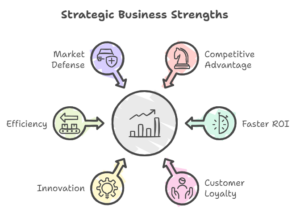Mastering the Art of Business Growth: Why Leveraging Your Strengths is the Only Strategy That Works
Let’s be honest, as an entrepreneur, you’ve heard a million times that “you need to leverage your strengths.” But what does that even mean in a practical sense? And more importantly, how does it actually help you grow your business without getting lost in the same old management jargon?
Don’t worry. I’m here to cut through the noise. Let’s dive into some key strategies for leveraging your business’s core strengths to fuel sustainable growth. And yes, we’ll talk about things like SWOT analysis and innovation—but this time, in a way that makes sense to your business, not just another corporate PowerPoint presentation.
Core Strengths: What Are They, Really?
Alright, first things first—what are these magical “core strengths” we’re supposed to leverage? Simply put, core strengths are the things your business does better than anyone else. Whether it’s your unique product design, your killer customer service, or even your team’s exceptional technical skills, these strengths are the bedrock upon which your business can grow.
Let’s say you’re running a software company. If your development team consistently delivers high-quality, bug-free products faster than your competitors, that’s a core strength. If you’re a boutique fashion brand and your customers rave about the craftsmanship of your garments, that’s your core strength.
Identifying these strengths is crucial because you can’t build a house on a shaky foundation, right?
Why Core Strengths Matter for Growth

Unpacking the Truth Behind Competitive Advantage
It’s not exactly news that your core strengths matter. You’ve likely heard it a million times. But the real question is: why do they matter so much, and how can leveraging these strengths deliver the kind of growth that turns a business from good to great?
Angle 1: The Unseen Power of Specialization
Imagine this: you’re an entrepreneur juggling a hundred things at once. You’ve got competitors on all sides, and you’re tempted to do a bit of everything to stay in the game. But here’s the deal—doing a little of everything means you’re likely to do nothing exceptionally well. That’s where core strengths come into play.
Specialising in your core strengths means you get to own a piece of the market. It’s the difference between being a “jack of all trades” and a master of one. The latter? That’s where the money is. When you master your strengths, you’re not just another competitor in the market—you’re the competitor. Whether it’s your ability to innovate faster, provide better customer service, or create a product that no one else can replicate, your strength gives you staying power and helps you carve out a niche that competitors can’t easily touch.
It’s like the famous Apple vs. everyone else saga. Apple doesn’t try to make the cheapest phone. They focus on innovation, design, and user experience—their core strengths. And guess what? People don’t just buy iPhones; they buy the brand. Their core strength isn’t just a feature; it’s their identity. And they don’t need to compete on price because they’ve honed their strength so well that customers see value beyond cost.
Angle 2: Strengths Lead to Faster Payback and Tangible Results
Here’s something most businesses overlook: the speed of returns on investment is almost always tied to your core strengths. When you leverage an area where you’re already strong, you see faster results. Why? Because you’re working from a position of expertise. You’ve done the groundwork, you’ve got the infrastructure, and more importantly, you’ve built the muscle memory that allows you to move quickly.
Let’s put this into context. Imagine two companies launching a new service. Company A decides to venture into a completely new area, something far from their expertise. They spend months (or years) developing processes, learning the market, and training staff. Company B, on the other hand, doubles down on a service that’s aligned with their core competency. They already know what works, have established trust in that space, and simply need to scale or improve their offering. Company B will almost always see a quicker return on their efforts, while Company A is still stuck figuring out the basics.
Your competitive advantage is like a speed dial to success. Every time you optimise and refine it, you cut down the learning curve, reduce risk, and fast-track payback. It’s why companies that understand and exploit their strengths tend to grow faster and more sustainably than those that spread themselves thin trying to do too much, too soon.
Angle 3: Strengths as a Catalyst for Long-Term Growth
When businesses chase growth, they often look to new markets or innovations. And while exploring new territory is important, here’s the kicker: the best growth strategies usually build on what you already do well. Strengths aren’t just something you lean on for quick wins—they are a platform for sustained, long-term growth.
Take Starbucks as an example. Their core strength has always been providing a consistent, high-quality customer experience. Over time, they didn’t just stick to selling coffee; they leveraged that strength to create an entire lifestyle brand. They diversified into merchandise, music, and mobile payment systems, but they didn’t stray from their core competency of delivering exceptional customer service in every interaction. Every new venture built on what they already did well. This is how you create a snowball effect for growth—by consistently expanding in ways that align with your strengths.
Angle 4: Strengths and the Psychological Edge
Let’s also consider the psychological advantage of working from a position of strength. When you know you’re good at something, it creates confidence. That confidence permeates through your team, your branding, and even your customer relationships. It’s no secret that businesses that exude confidence tend to attract more opportunities.
Think about it: would you rather invest in a business that’s tentative and unsure of its place in the market or one that knows exactly what it’s doing and excels at it? Confidence, rooted in your core strengths, becomes a self-fulfilling prophecy. When you believe in what you’re doing and you know you have the skills to back it up, you’re more likely to take the kind of bold, calculated risks that lead to big payoffs.
Angle 5: Strengths as a Competitive Moat
Let’s talk defence—because no matter how fast you grow, someone, somewhere, is trying to eat into your market share. Your core strengths don’t just help you grow; they help you defend. When you fully exploit your strengths, you’re building a moat around your business that competitors will struggle to cross.
Let’s use a real-life example: Amazon. Sure, they dominate in e-commerce, but their real core strength? Logistics. They’ve spent years perfecting their supply chain and delivery systems. Now, their logistics strength is so deeply ingrained that competitors can’t easily replicate it, even if they throw billions at the problem. It’s not just that Amazon is good at what they do—they’ve optimised and leveraged their logistics advantage to the point where it acts as a protective barrier against competition.
This kind of strategic strength-building doesn’t just boost profits; it creates an almost impenetrable advantage that keeps you on top, even as the market shifts.
Angle 6: Core Strengths and Innovation
Here’s a myth I’d love to debunk: that strengths and innovation are mutually exclusive. Spoiler alert: they’re not. In fact, your strengths are often the best jumping-off point for new ideas. The businesses that innovate successfully do so from a position of strength.
“Innovation starts where your strengths meet opportunity. Focus on what you excel at, and watch your business evolve into something unstoppable.”
Look at Netflix. Originally, they were known for their DVD rental service—a core strength that revolved around efficient content delivery. But instead of resting on that, they took their expertise in content distribution and used it as a springboard to innovate. Now they dominate the streaming industry and are even creating original content. Their innovation didn’t come from an area of weakness; it was a natural extension of their core strength.
Strengths, when optimised, aren’t just about doing the same thing over and over. They’re about creating a launching pad for new growth avenues. By focusing on what you do well, you can identify areas where you can innovate and push the boundaries in ways your competitors can’t.
“In the garden of potential, strengths are the fertile soil, nurturing the seeds of innovation and growth. As you cultivate your talents, you unlock new horizons, leaving competitors behind in the footprints of your unique journey.”
When you focus on what your business already excels at, you’re building from a place of strength (no pun intended). This gives you a competitive edge, makes it easier to innovate in your industry, and ultimately helps you grow more sustainably.

Identifying Your Core Strengths
Okay, so we know leveraging strengths is important, but how do you actually identify them? You’re not going to find them by sitting in a brainstorming session filled with wishful thinking. This requires a real, tangible assessment of your business operations.
Start with an organisational assessment—no, this doesn’t have to be a three-month-long consultancy project. You can begin by collecting feedback from different teams, analysing customer reviews, and looking at key performance indicators (KPIs). This will give you an internal view of what’s working well and where you’re dropping the ball.
Let’s say you are a retailer. After conducting an assessment, you realise that your supply chain management is top-notch. Your products always arrive on time, and your inventory management system is streamlined. But, your online customer service? Not so much. Now, you’ve identified a core strength (your supply chain) and a weakness (online customer service). Now, imagine the potential for growth if you double down on that strength and clean up your weaknesses. Exactly.
The Role of SMEs in Economic Growth
For all my small and medium enterprise (SME) owners out there, here’s something you may not hear enough: you are a backbone of economic growth. Your business might not be pulling in billions in revenue (yet), but don’t underestimate your role in the broader economy. SMEs contribute massively by creating jobs, fostering innovation, and keeping industries competitive. Essentially, you’re the lifeblood of a dynamic market, shaking up industries and pushing big players to step up their game.
Take, for example, a local craft brewery that stays competitive by offering unique, small-batch brews while the large commercial brewers continue cranking out the same old products. This SME doesn’t just survive—it thrives by focusing on its strength: small-batch quality. While the big guys struggle to innovate quickly, this brewery uses its agility as a key advantage.
Now imagine applying that same mindset to your business. How can your small scale become an asset, not a liability?
The Strategy: Growth Through Core Strengths
Let’s talk about tactics. When it comes to growth, your first instinct might be to throw spaghetti at the wall and see what sticks. I get it—growth feels like it should be all about expansion, new products, new markets, new everything. But here’s a radical thought: what if you focused on doing what you already do well, but better?
“Your business’s core strengths aren’t just assets—they’re your competitive superpower. Leverage them, and growth becomes inevitable.”
You can grow through differentiation—standing out from the crowd by amplifying what makes you unique. Let’s say you run a tech company known for seamless user experience. Why not lean all the way into that? Invest more in your user research, design better onboarding processes, and make your UX so good that customers can’t imagine using anything else.
On the flip side, maybe your strength is cost efficiency. If that’s the case, go full Walmart mode. Optimise your processes, cut unnecessary costs, and give your customers unbeatable prices while maintaining a decent margin. Whether you’re going for differentiation or cost leadership, the key is to focus on leveraging what you already do well to fuel growth.
SWOT Analysis: Not Just a Buzzword
If you’ve ever been to a business workshop, someone probably brought up SWOT analysis like it was the Holy Grail of strategic planning. And while it might sound like yet another management acronym, it’s actually a practical tool to help you understand your strengths, weaknesses, opportunities, and threats. You can think of SWOT as a business health check-up.
Picture this: You’re a boutique hotel. Your SWOT analysis reveals that your core strength is providing personalised service that chain hotels can’t match (Strength). But you also discover your website is outdated and slow (Weakness), which could be why potential guests bounce to competitors. Meanwhile, there’s a growing demand for staycations (Opportunity), but a new mega-hotel is opening up just a few blocks away (Threat).
This analysis helps you make informed decisions on where to allocate resources. Strengthen what’s working and improve what’s not.
Innovation: The Secret Sauce
Don’t get me wrong, innovation isn’t just about developing some breakthrough technology or disrupting an entire industry. Sometimes innovation is simply doing something better than the competition. It’s about being creative with the resources you already have.
Take Netflix, for instance. They didn’t invent streaming, but they sure as heck leveraged their core strength—content delivery—better than anyone else. The lesson?
You don’t need to reinvent the wheel, but you do need to keep it turning.
Unique Growth Strategies: It’s Not All About Scale
Contrary to what you might think, growth isn’t always about getting bigger. It’s about getting smarter. Viral loops, customer referrals, and milestone rewards aren’t just for Silicon Valley startups. Whether you’re in retail, tech, or even construction, unique growth strategies can help you expand without adding tons of overhead.
For example, you can introduce a referral program to leverage word-of-mouth marketing or start a loyalty rewards system to increase repeat customers. The goal isn’t necessarily to expand your product line but to deepen relationships with the customers you already have.
Sustainable Growth Practices: Think Long-Term
Now, onto something often ignored—sustainable growth. Sure, rapid growth is fun to chase, but what happens when you’ve maxed out your capacity? Are you ready to crash and burn? Sustainable growth means thinking long-term. It’s about leveraging your strengths but making sure you have the infrastructure to support that growth without imploding.
A near-market expansion might involve moving into a new, adjacent product category or geography where your existing strengths still apply. For instance, if you’re a successful clothing brand, expanding into accessories or footwear might be a natural progression. This kind of growth allows you to diversify and spread your risk.
Actionable Tactics for Maximising Profitability
Here’s where the rubber meets the road—actual, actionable tactics you can use to drive profitability. Whether you’re looking to improve customer retention, reduce costs, or increase sales, your core strengths will serve as the foundation for these tactics.
Want an example? Let’s say you run an e-commerce business. One of your strengths is your fast delivery network. How can you leverage that? Create a membership program like Amazon Prime that incentivises customers to stick around longer and shop more frequently. Or, if you have a top-notch customer service team, lean into that by offering personalised shopping experiences.
The key takeaway here is to align your tactics with your strengths. You’ll find that this not only maximises profitability but also makes your growth sustainable.
Play to Your Strengths
So, what have we learned today? Growth isn’t about chasing every shiny object or expanding for expansion’s sake. It’s about knowing what your business does best and doubling down on that.
The path to sustainable growth is clear—leverage your core strengths, refine what’s working, and always be on the lookout for ways to innovate within your sweet spot. Sustainable growth is like building a skyscraper. If your foundation (core strengths) is weak, the whole thing comes crashing down. But if you get that foundation right, the sky’s the limit.
Strengths as the Ultimate Growth Driver
In a world where businesses chase the next big thing, it’s easy to overlook what’s already working. But here’s the truth: sustainable growth almost always comes from doubling down on your core strengths. These are the areas where you’ve built expertise, where you have a competitive advantage, and where you can see the fastest returns.
“True success doesn’t come from chasing trends. It comes from mastering what you already do best and using it to dominate your market.”
By refining and optimising what you’re already good at, you not only fuel growth but also create a competitive edge that’s difficult for others to replicate. And as you continue to leverage these strengths, you’re laying the foundation for both immediate results and long-term success.
So, the next time you’re thinking about your growth strategy, stop chasing the next shiny object. Look inward, find your core strengths, and leverage the hell out of them. Because that, my friend, is where the real payback lies.



